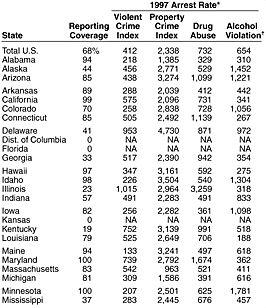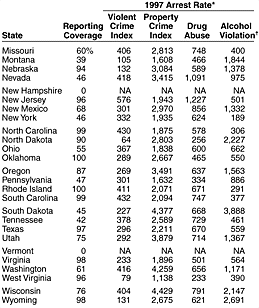|
State drug and alcohol statistics
 
* Throughout this Bulletin, juvenile arrest rates are calculated by dividing the number of arrests of persons ages 10-17 by the number of 10- through 17-year-olds in the population. In this table only, arrest rate is defined as the number of arrests of persons under age 18 for every 100,000 persons ages 10-17. Juvenile arrests (arrests of youth under age 18) reported at the State level in Crime in the United States cannot be disaggregated into more detailed age categories so that the arrest of persons under age 10 can be excluded in the rate calculation. Therefore, there is a slight inconsistency in this table between the age range for the arrests (birth through age 17) and the age range for the population (ages 10-17) that are the basis of a State's juvenile arrest rate. This inconsistency is slight because just 2% of all juvenile arrests involved youth under age 10. However, this inconsistency is preferred to the distortion of arrest rates that would be introduced were the population base for the arrest rate to incorporate the large volume of children in a State's birth to 9-year-old population.
+ Alcohol violations include liquor law violations, drunkenness, and driving under the influence.
NA = Crime in the United States 1997 reported no arrest counts for this State.
Interpretation cautions: Arrest rates are calculated by dividing the number of youth arrests made in the year by the number of youth living in reporting jurisdictions. While juvenile arrest rates in part reflect juvenile behavior, many other factors can affect the size of these rates. For example, jurisdictions that arrest a relatively large number of nonresident juveniles would have a higher arrest rate than a jurisdiction whose resident youth behave in an identical manner. Therefore, jurisdictions that are vacation destinations or regional centers for economic activity may have arrest rates that reflect more than the behavior of their resident youth. Other factors that influence the magnitude of arrest rates in a given area include the attitudes of its citizens toward crime, the policies of the jurisdiction's law enforcement agencies, and the policies of other components of the justice system. Consequently, comparisons of juvenile arrest rates across States, while informative, should be made with caution. In most States, not all law enforcement agencies report their arrest data to the FBI. Rates for these States are then necessarily based on partial information. If the reporting law enforcement agencies in these States are not representative of the entire State, then the rates will be biased. Therefore, reported arrest rates for States with less than complete reporting coverage may not be accurate.
Data source: Analysis of arrest data from the FBI's
Crime in the United States 1997 (Washington, DC: U.S. Government Printing Office, 1998), tables 5 and 69, and population data from the U.S. Bureau of the Census' Population of the U.S. and States by Single Year of Age and Sex: 1997 [machine-readable data file released in August 1998].
| ||||